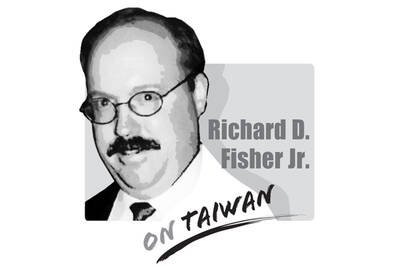The march on Saturday last week against nuclear power, under the theme “Farewell to Nuclear Power for a Beautiful Future,” called for saying goodbye to nuclear power plants, which the marchers said pose safety risks and leave the nation with difficult-to-process nuclear waste, and turning instead toward renewable and sustainable alternatives.
This year, with the second reactor at the Kuosheng Nuclear Power Plant going through major maintenance, and the first reactor at the Ma-anshan Nuclear Power Plant offline due to issues with an emergency diesel generator, only the first reactor at the former and the second reactor at the latter are operational.
However, they are still producing enough energy to meet the nation’s needs. Even with the peak usage at 1:50pm on Wednesday last week, renewable energy sources provided 9.23 percent of the total, higher than the 5.794 percent provided by nuclear power plants.
Taiwan’s renewable energy installed capacity continues to increase, Atomic Energy Council figures show. In 2017, installed capacity stood at 10.6 percent, already surpassing the 10.3 percent nuclear installed capacity. In February, installed capacity for renewables was 12.1 percent, compared with 8.5 percent for nuclear installed capacity.
The gap will increase when the license for the second reactor at the Jinshan Nuclear Power Plant expires in July.
Taiwan is on the convergent boundary between the Eurasian Plate and the Philippine Plate, and experiences frequent earthquakes. Using nuclear power carries the risk of accident to a degree far higher than other nations with more stable geological conditions.
In addition, the nation’s latitudinal position gives it significant solar resources. A 2014 analysis by international engineering consultancy 4C Offshore said that of the 20 offshore windfarm locations worldwide, the 16 with the strongest wind power were in the Taiwan Strait.
Even if the mothballed Fourth Nuclear Power Plant was operational, research by National Taiwan Ocean University shows that Taiwan’s geothermal resources could provide the equivalent to 65 of the plants.
Geologically speaking, Taiwan is ready to say farewell to nuclear power.
With nuclear power on the decline, its advocates in Taiwan are dressing up their ideas in sophisticated packaging, suggesting that nuclear is the way to reduce coal burning.
Yet, according to council statistics, coal power accounted for 46 percent of nationwide energy provision last year, far higher than the 10 percent provided by nuclear power.
How many new reactors would be needed to provide more power than coal-powered generation? Where would these be located? Would local residents accept this?
When nuclear advocates tout nuclear power as a way to reduce carbon emissions, are they really using coal as an excuse to increase nuclear power generation?
Nuclear power is large-scale, centralized power generation: When a reactor fails, it results in a large reduction in power provision.
Renewable energy is more decentralized, so a simultaneous failure of several generators leads only to a reduction in efficiency, requiring only more careful management of storage and demand to maintain a stable supply.
Internationally, companies are increasingly emphasizing corporate and social responsibility, and many have joined the RE100 initiative committed to using 100 percent renewable energy.
If Taiwan wants to conduct business in the international community, it will have to keep up with international trends.
Tsai Ya-ying is a lawyer affiliated with the Wild at Heart Legal Defense Association.
Translated by Paul Cooper
We are used to hearing that whenever something happens, it means Taiwan is about to fall to China. Chinese President Xi Jinping (習近平) cannot change the color of his socks without China experts claiming it means an invasion is imminent. So, it is no surprise that what happened in Venezuela over the weekend triggered the knee-jerk reaction of saying that Taiwan is next. That is not an opinion on whether US President Donald Trump was right to remove Venezuelan President Nicolas Maduro the way he did or if it is good for Venezuela and the world. There are other, more qualified
China’s recent aggressive military posture around Taiwan simply reflects the truth that China is a millennium behind, as Kobe City Councilor Norihiro Uehata has commented. While democratic countries work for peace, prosperity and progress, authoritarian countries such as Russia and China only care about territorial expansion, superpower status and world dominance, while their people suffer. Two millennia ago, the ancient Chinese philosopher Mencius (孟子) would have advised Chinese President Xi Jinping (習近平) that “people are the most important, state is lesser, and the ruler is the least important.” In fact, the reverse order is causing the great depression in China right now,

This should be the year in which the democracies, especially those in East Asia, lose their fear of the Chinese Communist Party’s (CCP) “one China principle” plus its nuclear “Cognitive Warfare” coercion strategies, all designed to achieve hegemony without fighting. For 2025, stoking regional and global fear was a major goal for the CCP and its People’s Liberation Army (PLA), following on Mao Zedong’s (毛澤東) Little Red Book admonition, “We must be ruthless to our enemies; we must overpower and annihilate them.” But on Dec. 17, 2025, the Trump Administration demonstrated direct defiance of CCP terror with its record US$11.1 billion arms
The immediate response in Taiwan to the extraction of Venezuelan President Nicolas Maduro by the US over the weekend was to say that it was an example of violence by a major power against a smaller nation and that, as such, it gave Chinese President Xi Jinping (習近平) carte blanche to invade Taiwan. That assessment is vastly oversimplistic and, on more sober reflection, likely incorrect. Generally speaking, there are three basic interpretations from commentators in Taiwan. The first is that the US is no longer interested in what is happening beyond its own backyard, and no longer preoccupied with regions in other